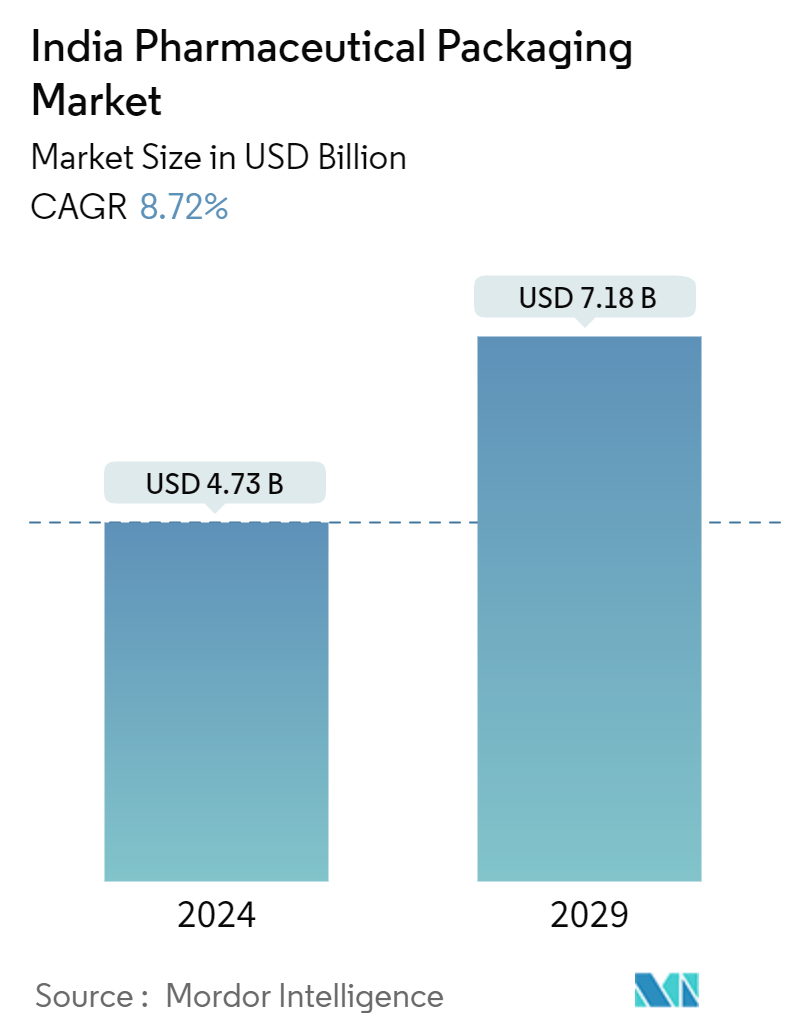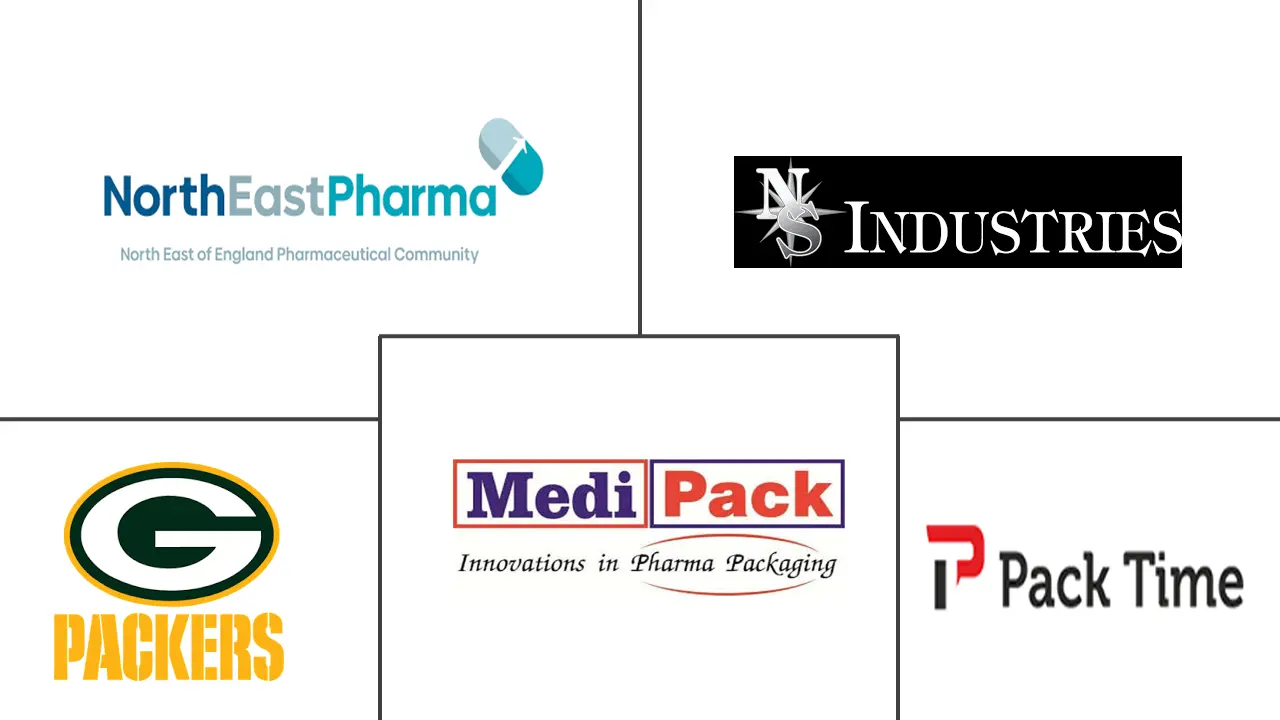Market Size of India Pharmaceutical Packaging Industry

| Study Period | 2019 - 2029 |
| Base Year For Estimation | 2023 |
| Market Size (2024) | USD 4.73 Billion |
| Market Size (2029) | USD 7.18 Billion |
| CAGR (2024 - 2029) | 8.72 % |
| Market Concentration | Low |
Major Players
*Disclaimer: Major Players sorted in no particular order |
India Pharmaceutical Packaging Market Analysis
The India Pharmaceutical Packaging Market size is estimated at USD 4.73 billion in 2024, and is expected to reach USD 7.18 billion by 2029, growing at a CAGR of 8.72% during the forecast period (2024-2029).
Pharmaceutical packaging uses materials designed to transfer and store pharmaceutical drugs safely. These materials are selected based on the drugs' characteristics, aiming to safeguard, identify, and maintain the integrity of the enclosed product. The packaging process ensures that the drugs are protected from external factors such as contamination, physical damage, and environmental conditions, which could potentially compromise their efficacy and safety. Pharmaceutical packaging is crucial in providing essential information about the drug, including dosage instructions and regulatory compliance details.
- Pharmaceutical drugs face various hazards, spanning mechanical, chemical, biological, and climatic risks. They are packaged using multiple materials, including plastics, paper, glass, and metal, and tailored to different delivery methods, such as oral, pulmonary, injectable, transdermal, topical, interventional, nasal, and ocular.
- The Indian government has implemented extensive and ongoing reforms to bolster the pharmaceutical industry, unveiling policies to foster foreign direct investments (FDI). As part of the Aatmanirbhar Bharat Abhiyaan initiative, the government has introduced a range of short- and long-term measures to fortify the health system. These include implementing Production-linked Incentive (PLI) schemes specifically designed to enhance domestic pharmaceutical and medical device manufacturing. Moreover, India is actively positioning itself as a destination for spiritual and wellness tourism, leveraging its strengths in Ayurveda and yoga practices. These strategic moves are poised to impact the market studied significantly.
- The pharmaceutical packaging market in India is under increasing scrutiny for its impact on ecosystems and human health, given the escalating environmental concerns. The push for sustainability in the pharmaceutical industry is not just about reducing its carbon footprint but also about safeguarding ecosystems and public health for the long haul, especially in a country like India. The demand for eco-friendly and sustainable pharmaceutical packaging solutions is growing rapidly, driven by the need to address these environmental challenges effectively.
- Moreover, supplier bargaining power directly impacts pricing and quality, thereby dictating the value chain and, ultimately, the products and services delivered to consumers. As a supplier's power grows, so do the costs of raw materials, subsequently elevating the final product's price tag.
- The Indian pharmaceutical industry was already a major global player known for its generic drug manufacturing. The increasing demand for pharmaceutical products both domestically and internationally drove the need for diverse and advanced packaging solutions. The development and distribution of COVID-19 vaccines required specialized packaging solutions, including vials, syringes, and cold chain packaging, to ensure safe and effective delivery. According to the Ministry of Health and Family Welfare (India), the Indian state of Utter Pradesh reported the highest number of administered doses of the vaccine against the coronavirus as of November 13, 2023.
India Pharmaceutical Packaging Industry Segmentation
Pharmaceutical packaging is the packaging process for pharmaceutical products. The packaging material can be of several raw materials, such as glass and plastic, and its application depends on the reactivity of the pharmaceutical products to be packaged. The report provides a granular view of the pharmaceutical packaging industry in India with a breakdown of segments by product type and material type. The market is defined by the revenue accrued from the sales of different pharmaceutical packaging products offered by various vendors operating in the market.
The Indian pharmaceutical packaging market is segmented by material type (plastic, glass, and other material types) and product type (bottles, vials and ampoules, syringes, tubes, caps and closures, pouches and bags, labels, and other product types). The market sizes and forecasts are provided in terms of value (USD) for all the above segments.
| By Material Type | |
| Plastic | |
| Glass | |
| Other Material Types |
| By Product Type | |
| Bottles | |
| Vials and Ampoules | |
| Syringes | |
| Tubes | |
| Caps and Closures | |
| Pouches and Bags | |
| Labels | |
| Other Product Types |
India Pharmaceutical Packaging Market Size Summary
The Indian pharmaceutical packaging market is poised for significant growth, driven by the country's robust pharmaceutical sector, which is increasingly becoming a hub for research and innovation. This growth is supported by India's strong science and technology base, government initiatives, and cost-competitive manufacturing capabilities, making it an attractive destination for global pharmaceutical companies. The market is expected to expand due to rising retail pharmacy penetration and an increasing prevalence of chronic diseases, necessitating advanced packaging solutions. The government's health initiatives, such as the Ayushman Bharat scheme, further bolster the demand for pharmaceutical packaging by providing free health coverage to the underprivileged, thereby increasing the need for efficient and sustainable packaging solutions.
The market landscape is characterized by a semi-consolidated structure, with major players like West Pharmaceutical Packaging Pvt. Ltd, Geresheimer AG, and SGD Pharma leading the charge. These companies are leveraging strategic collaborations and technological advancements to enhance their market presence and profitability. The demand for glass packaging is particularly on the rise, driven by its eco-friendly properties and suitability for various pharmaceutical products. The Indian pharmaceutical packaging industry is also witnessing increased investments and expansions, such as the establishment of new glass tubing facilities and the introduction of innovative packaging solutions. These developments are expected to meet the growing global demand for pharmaceutical products, with India playing a pivotal role as a major exporter of medicines and vaccines.
India Pharmaceutical Packaging Market Size - Table of Contents
-
1. MARKET INSIGHTS
-
1.1 Market Overview
-
1.2 Industry Attractiveness - Porter's Five Forces Analysis
-
1.2.1 Bargaining Power of Suppliers
-
1.2.2 Bargaining Power of Buyers
-
1.2.3 Threat of New Entrants
-
1.2.4 Threat of Substitutes
-
1.2.5 Degree of Competition
-
-
1.3 Industry Value Chain Analysis
-
1.4 Assessment of the Impact of Microeconomic Factors on the Market
-
-
2. MARKET SEGMENTATION
-
2.1 By Material Type
-
2.1.1 Plastic
-
2.1.2 Glass
-
2.1.3 Other Material Types
-
-
2.2 By Product Type
-
2.2.1 Bottles
-
2.2.2 Vials and Ampoules
-
2.2.3 Syringes
-
2.2.4 Tubes
-
2.2.5 Caps and Closures
-
2.2.6 Pouches and Bags
-
2.2.7 Labels
-
2.2.8 Other Product Types
-
-
India Pharmaceutical Packaging Market Size FAQs
How big is the India Pharmaceutical Packaging Market?
The India Pharmaceutical Packaging Market size is expected to reach USD 4.73 billion in 2024 and grow at a CAGR of 8.72% to reach USD 7.18 billion by 2029.
What is the current India Pharmaceutical Packaging Market size?
In 2024, the India Pharmaceutical Packaging Market size is expected to reach USD 4.73 billion.

